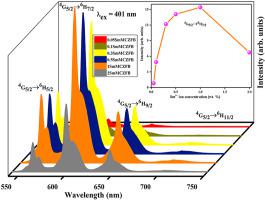Solid State Sciences ( IF 3.4 ) Pub Date : 2021-03-31 , DOI: 10.1016/j.solidstatesciences.2021.106606 K. Mariselvam , Juncheng Liu

|
A new series of Sm3+ ions doped magnesium cadmium zinc borophosphate (Sm3+: MCZBP) glasses were prepared with melt quenching, and were characterized with X-ray diffraction, optical absorption spectra, excitation spectrum, emission spectra, and fluorescence decay curves. The increase of Sm3+ ions concentration increased the density (ρ), refractive index (n) and decreased the molar volume (Vm) of the glass. The non-metallic nature was identified from the metallization factor (M). The optical absorption spectra were used to understand the optical band gap (direct and indirect). The oscillator strength and Judd-Ofelt (JO) intensity parameters were determined from the optical absorption spectra and further used to evaluate the radiative properties of the Sm3+ ions doped glasses. The luminescence spectra showed the four emissions from transitions 4G5/2→6HJ (J = 5/2, 7/2, 9/2, and 11/2), corresponding to 562 nm (17793 cm−1), 597 nm (16750 cm−1), 644 nm (15527 cm−1) and 704 nm (14204 cm−1) upon exciting with 401 nm (24937 cm−1) wavelength, respectively. CIE chromaticity co-ordinates (x, y), the colour purity (CP), and the correlated colour temperature (CCT) values were calculated, showing that the emission colour fell in the reddish-orange region. The experimental lifetime (τexp), quantum efficiency (η), stimulated emission cross-section (), gain bandwidth (), and optical gain parameter () were articulated from the emission spectra of the glasses. The decay curves of 4G5/2 excited state exhibited non-exponential profile for all the present glasses. The efficient energy transfer between two Sm3+ ions through cross-relaxation was analysed with Inokuti-Hirayama (IH) model (S = 6). All the absorption and spectroscopic results revealed that 1SmMCZBP glass had a strong reddish-orange emission at 597 nm corresponding to 4G5/2 → 6H7/2 transition, and could be very promising material for laser and multi-colour display.
中文翻译:

Jud-Ofelt分析和Sm 3+的可见光:MCZBP玻璃,用于红橙色激光和多色显示应用
用熔融淬火制备了一系列新的掺有Sm 3+离子的镁硼酸锌镉锌玻璃(Sm 3+:MCZBP),并通过X射线衍射,光吸收光谱,激发光谱,发射光谱和荧光衰减曲线进行了表征。 。Sm 3+离子浓度的增加增加了玻璃的密度(ρ),折射率(n)并降低了摩尔体积(V m)。从金属化因子(M)。光学吸收光谱用于了解光学带隙(直接和间接)。由光吸收光谱确定振荡器强度和Judd-Ofelt(JO)强度参数,并将其进一步用于评估掺杂Sm 3+离子的玻璃的辐射性能。发光光谱显示了来自跃迁4 G 5/2 → 6 H J(J = 5 / 2、7 / 2、9 / 2和11/2)的四种发射,对应于562 nm(17793 cm -1),401 nm(24937 cm -1)激发后为597 nm(16750 cm -1),644 nm(15527 cm -1)和704 nm(14204 cm -1))波长。计算了CIE色度坐标(x,y),色纯度(CP)和相关色温(CCT)值,显示出发射色落在红橙色区域。实验寿命(τ EXP),量子效率(η),受激发射横截面(),获得带宽(),以及光学增益参数(从玻璃的发射光谱中清楚地看出)。对于所有当前的玻璃,4 G 5/2激发态的衰减曲线显示出非指数分布。通过Inokuti-Hirayama(IH)模型(S = 6)分析了通过交叉松弛在两个Sm 3+离子之间的有效能量转移。所有吸收和光谱结果表明,1SmMCZBP玻璃在597 nm处具有强烈的红橙色发射,对应于4 G 5/2 → 6 H 7/2跃迁,对于激光和多色显示可能是非常有前途的材料。











































 京公网安备 11010802027423号
京公网安备 11010802027423号